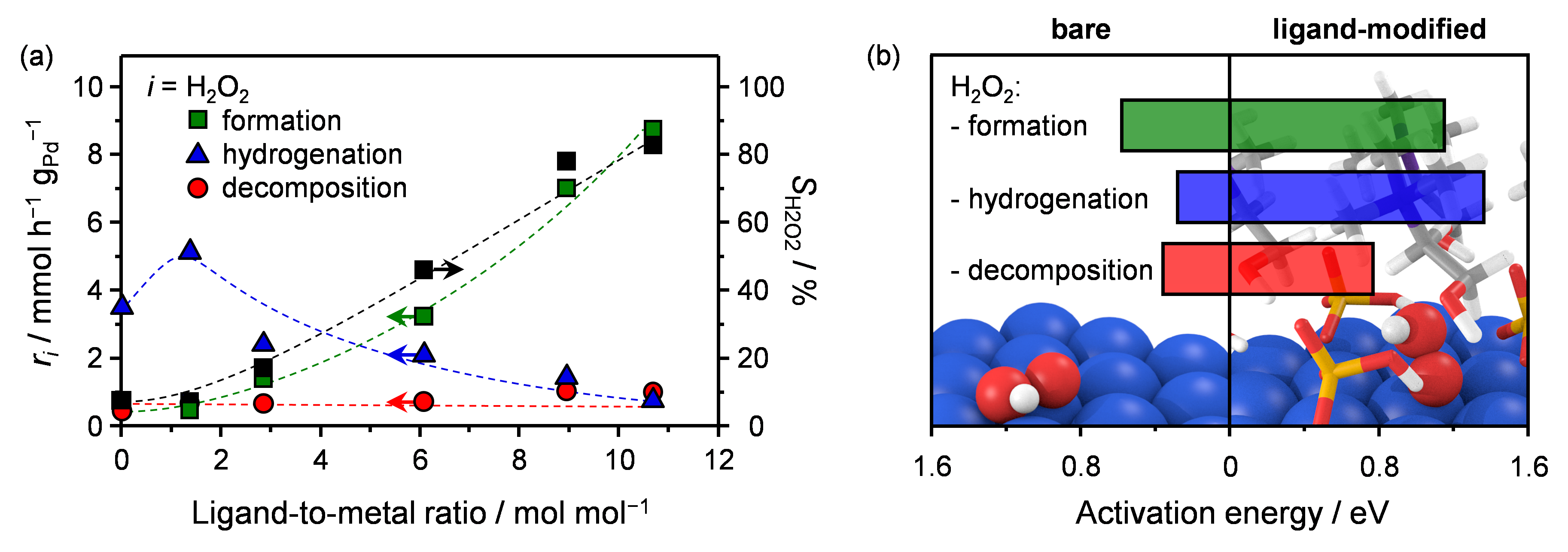Hybrid palladium nanoparticles for direct H2O2 synthesis: the key role of the ligand
Hydrogen peroxide, H2O2, attracts growing attention as a green alternative to traditional stoichiometric oxidants in a wide range of applications. Its direct synthesis from H2 and O2 is an appealing substitute to the current manufacture based on the anthraquinone route, having the potential to be exploited in decentralized plants at any scale due to the (i) absence of organic substrates, (ii) utilization of environmentally-friendly solvents such as water or methanol, and (iii) simplified purification. In this work,1 we demonstrate that ligand-stabilized palladium nanoparticles deposited on a carbon support are, by virtue of their unique nanostructure, active, selective, and stable catalysts for the direct synthesis of H2O2. In fact, progressive addition of the ligand was shown to boost the selectivity from 10% for bare nanoparticles up to 80% (Figure 1a), thus rivalling that obtained with state-of-the-art bimetallic catalysts.2 Furthermore, the catalyst remains stable over five consecutive reaction runs owing to the high resistance to leaching of the organic moiety, which arises from its strong interaction with the metal surface. Density Functional Theory studies rationalized this behavior based on the adsorption mode of reaction intermediates on the metal surface (Figure 1b). Whereas they lie flat in the absence of the organic shell, their electrostatic interaction with the ligand results in a unique vertical configuration which increases the activation energy associated with further dissociation and over-hydrogenation (Figure 1b). These results demonstrate the applicability of hybrid materials for the direct synthesis of H2O2 and highlight the importance of understanding the molecular role of the organic ligand for the design of novel nanocatalysts.

Figure 1 (a) Effect of the ligand-to-metal molar ratio on the H2O2 formation, decomposition, and hydrogenation reactions and (b) the activation energies of these reactions over the bare and hybrid palladium nanoparticles. The drawings in panel (b) represent the configuration of the adsorbed hydroperoxyl (OOH) intermediate.
[1] G. M. Lari, B. Puértolas, M. Shahrokhi, N. López, J. Pérez-Ramírez, Angew. Chem. Int. Ed. 2017, 56, 1775.
[2] S. J. Freakley, Q. He, J. H. Harrhy, L. Lu, D. A. Crole, D. J. Morgan, E. N. Ntainjua, J. K. Edwards, A. F. Carley, A. Y. Borisevich, C. J. Kiely, G. J. Hutchings, Science 2016, 351, 965.